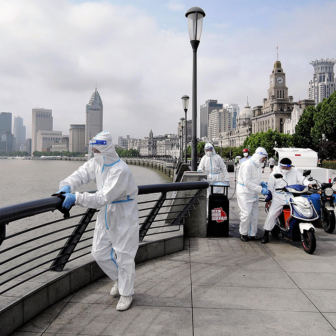Australia is facing its toughest challenge yet. In the first months of the outbreak, there was much back-patting for our collective success in “crushing the curve.” But we did nothing of the sort. We turned off the tap by limiting and quarantining international arrivals with overseas-acquired infections. For all the alarmist talk of exponential increase, the early curve was not the product of an uncontrolled local outbreak. It reflected testing and tracing of overseas arrivals. As we eased out of lockdown, I called attention to the danger of an epidemic rebound beginning among precarious workers. This has now happened.
Just as it did elsewhere, the Victorian outbreak emerged out of clusters among casualised workers in meatworks, aged care, childcare, private security, fast food and freight. These are “essential workers” who are not covered by stay-home directives. (Nobody knows how many people fall in this category.) The work cannot be done from home, and the workers are often employed by labour hire firms and “booked” shift by shift. They don’t get sick leave or annual leave, and they may lose shifts, or the job altogether, if they are unwell and decide to isolate. Many are temporary migrants and ineligible for social security, so losing a job can mean instant family hardship.
Extended family and community networks are essential resources for coping with financial insecurity. Yet contagion travels easily when people work across multiple sites and jobs and even industries, and when community events bring many families together. This is how seeds can incubate into clusters and generate an outbreak of uncontrolled community transmission. Victoria has only just introduced modest, ex gratia payments for casual workers required to self-isolate; the ACTU has only just issued a call for paid leave for this workforce. We needed to have a hard conversation about inequity and vulnerability, and we dodged it, with terrible consequences.
One of the big distractions has been the manufactured controversy over masks. A field of commentators, led by UNSW’s Raina MacIntyre and the ABC’s Norman Swan, has maintained steady media pressure on the Australian Health Protection Principal Committee, or AHPPC, and the national cabinet to recommended mask wearing by the general public. This week, they had a significant win, with the Victorian government announcing $200 fines for anyone caught in public without a face covering. Yet the evidence for mask wearing is surprisingly thin, and the mask advocacy conceals a remarkably ambitious claim. Even as masks become part of everyday life, the controversy threatens to draw attention away from the drivers of Australia’s outbreak and the control strategies that are already known to work.
Apart from 5G protesters and sovereign citizens, nobody denies that masks work. The World Health Organization, the AHPPC and the Communicable Diseases Network Australia all recommend masks be worn by healthcare workers, who are most likely to encounter the virus. Experience on Covid-19 wards has shown that standard precautions, when followed carefully, have proven sufficient protection against infection. The paradox is that masks are effective when Covid-19 is either guaranteed or likely to be present. It is much less clear that masks offer any benefit when worn elsewhere.
The question is what masks work for. As I have noted, they are an effective personal protection strategy when Covid-19 is known or likely to be present. But mask advocates argue that requiring people to wear masks in public can be an effective epidemic control strategy — perhaps even capable of eliminating an ongoing outbreak if enough people wear them in daily life. Going further, they claim that SARS-CoV-2 is capable of airborne transmission, and accuse the WHO of refusing to acknowledge the evidence for this. If true, this would change everything.
Early in the pandemic, the WHO published technical guidance identifying droplet transmission — the transfer of trace amounts of respiratory secretions (spit and mucus) from an infected person, often via touch, to a susceptible person — as the primary route of infection. That’s why we all wash our hands frequently and avoid touching our faces, public surfaces and other people. (For more on the differences between droplets and aerosols, see this Inside Story explainer.)
This determination was based on a review of China’s efforts in contact tracing more than 75,000 cases during its initial outbreak, which coincided with mass internal migration for family celebrations of the Chinese New Year. If airborne transmission were even a minor probability, characteristic patterns of infection would have been visible — from space — in the contact-tracing data.
Aerosol scientists contend that droplets from coughs and sneezes — and perhaps even exhaled breath alone — can travel more than two metres and carry virus particles with them, posing a risk of airborne transmission. Responding to a recent letter with 237 cosignatories, the WHO updated its technical guidance. It observes that the studies cited in the letter don’t answer the “enough” question: do fine droplets from coughing, sneezing and exhaled breath carry enough virus to cause infection? Months later, epidemiological data still don’t support the claim of widespread aerosol transmission. Airborne viruses show much higher reproductive numbers and secondary attack rates than Covid-19 does.
The WHO said it remains open to further evidence regarding the “specific settings” — such as the choir cluster — that the letter cites to suggest airborne transmission has occurred. But it observes that these events could equally be explained by droplet transmission, and they already fit the risk scenarios identified early in the outbreak, which include face-to-face contact and spending two hours-plus in an enclosed space.
When Victoria first recommended wearing masks it used the same language — as an option in specific settings where physical distancing is not possible. Yet mask advocates called for a more general mandate. Chief among them, Professor MacIntyre is a media-savvy performer whose freedom to offer public comment is not constrained by any role advising governments on the crisis. She is adamant both that Covid-19 is airborne and that masks should be mandatory.
MacIntyre has led a number of experimental studies of mask wearing for personal protection and source control in healthcare and the community. And this is where it gets odd: MacIntyre’s own findings don’t support her claims.
A systematic review by the Cochrane Acute Respiratory Infections panel pooled data from fourteen randomised trials, including five led by Professor MacIntyre. It found no reduction in influenza-like illness in either healthcare workers or the general population as a result of masks. The one statistically significant result was that cloth face coverings are worse than even inconsistent use of surgical masks in general nursing. That finding came from MacIntyre’s own work. The reviewers note that many trials were poorly designed and lacked sufficient sample sizes, and none took place during a pandemic. Based on clinical experience during SARS, though, they recommend masks combined with other measures for personal protection.
In preparing an earlier piece, I combed through this literature along with studies of respiratory aerosols and virus deposition by air currents. A common theme emerged. Papers that don’t report significant effects — protective benefits from masks, or infectious virus in air currents — use the limitations section of their reports to undercut their own findings, offering post hoc rationalisations and calling for further studies. (In this way, even negative findings are interpreted as evidence of an expected, inevitable outcome.) Small sample sizes leave studies “under-powered” (unable to detect less common events), so their estimates come with very wide confidence intervals. MacIntyre’s largest study of masks was pulled up by peer reviewers for failing to adjust for confounders after non-random assignment of trial sites to the control and intervention arms. Following the adjustment, the findings were no longer statistically significant.
Conducting a systematic review or mathematical model can’t clarify matters when their inputs — the empirical studies — are poor quality. Modelling studies on mask wearing as an epidemic control strategy often assume degrees of effectiveness rather than using modest empirical estimates. One model, assuming 70 per cent effectiveness, concluded that mask wearing could eliminate the virus in a major US metropolis in a matter of weeks. You can see the problem if political leaders, taking that message to heart, decide that mask wearing is an alternative to lockdown.
The danger posed by the mask discourse is distraction. A distraction from what we already know, with certainty, about the virus and how it is passed on. From the drivers of this new outbreak, which are still workplaces, social events and family gatherings, most of which involve close and prolonged contact and are not covered by the mask mandate. From what works to control outbreaks, including aggressive contact tracing, testing and isolation. From banning the events and settings where transmission can occur. From dealing with huge gaps in lockdown arrangements that exempt essential workers, even though precarious work arrangements caused this second wave. And from the trust in our public health experts that characterised our early response.
Earlier in this piece I distinguished between using masks for personal protection and mandating masks for epidemic control. Working in HIV prevention, I encourage people to use whatever prevention method works for them, and I do the same with masks. If wearing a mask would make you feel safer, do it! Wearing face coverings can be a powerful expression of our shared commitment to ending the outbreak, and making face coverings lets us find creativity in dark times.
I wouldn’t be a health promotion worker if I didn’t tell you what to do, so here are two suggestions. Remember to change and wash your masks often, otherwise they will harbour germs just like a dirty hanky would. And remember that the situations of greatest risk are close contact and gatherings, not momentary breaches of the 1.5 metre rule in the supermarket queue. Stopping gatherings, and reducing contacts outside our household are both essential for interrupting chains of transmission.
As an epidemic control strategy, the case for public masking is strongest where prevalence rates are high and transmission is uncontrolled. Under these conditions, contact tracing and testing are overwhelmed. It is a “might as well, can’t hurt” strategy. When infection is rampant, even a small protective benefit can add up to a helpful difference in total infections. If I were in London, catching a crowded Tube service, I would wear a mask. But despite alarming numbers in Victoria, and ongoing “ember attack” in New South Wales, the prevalence in both states remains low, and thus masks are unlikely to make much difference.
Advocacy for masks is not informed by the brutal realities of crisis management and health communication. Thirty years of condom promotion show that just because a recommendation is simple does not mean it’s easy to communicate. The publicity blitz required to promote correct and consistent mask use comes with an opportunity cost. Airtime and public attention are finite resources. We need to concentrate on our epidemic drivers and reinforce public participation in high-impact strategies already proven to work. •
Bonus reading: A plain language summary of the Cochrane review by Australian experts Chris Del Mar and Paul Glasziou




